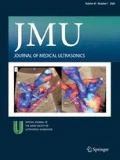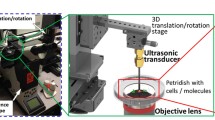Abstract
Part one of this review focused on the thermal and mechanical effects of low-intensity ultrasound (US). In this second and final part of the review, we will focus on and discuss various aspects of low-intensity US, with emphasis on the biomolecular effects, US-mediated gene transfection (sonotransfection), and US-mediated permeabilization (sonopermeabilization). Sonotransfection of different cell lines in vitro and target tissues in vivo have been reported. Optimization experiments have been done and different mechanisms investigated. It has also been found that several genes can be up-regulated or down-regulated by sonication. As to the potential therapeutic applications, systemic or local sonotransfection might also be a safe and effective gene therapy method in effecting the cure of local and systemic disorders. Gene regulation of target cells may be utilized in modifying cellular response to a treatment, such as increasing the sensitivity of diseased cells while making normal cells resistant to the side effects of a treatment. Advances in sonodynamic therapy and drug sonopermeabilization also offer an ever-increasing array of therapeutic options for low-intensity US.
Similar content being viewed by others
References
Kondo T, Krishna CM, Riesz P. Pyrolysis radicals formed by ultrasound in aqueous solutions of nucleotides: a spin trapping study. Int J Radiat Biol 1990;57(1):23–33.
Feril LB Jr, Kondo T. Biological effects of low-intensity ultrasound: the mechanism involved and its implications on therapy and on biosafety of ultrasound. J Radiat Res 2004;45(4):479–489.
Feril LB Jr, Kondo T, Umemura S, et al. Sound waves and antineoplastic drugs: the possibility of an enhanced combined anticancer therapy. J Med Ultrason 2002;29:173–187.
Riesz P, Kondo T. Free radical formation induced by ultrasound and its biological implications. Free Radic Biol Med 1992;13(3):247–270.
Feril LB Jr, Kondo T. Major factors involved in the inhibition of ultrasound-induced free radical production and cell killing by presonication incubation or by high cell density. Ultrason Sonochem 2005;12(5):353–357.
Feril LB Jr, Kondo T, Tabuchi Y, et al. Biomolecular effects of low-intensity ultrasound: apoptosis, sonotransfection, gene expression. Jpn J Appl Phys 2007;46(7B):4435–4440.
Kagiya G, Ogawa R, Tabuchi Y, et al. Expression of heme oxygenase-1 due to intracellular reactive oxygen species induced by ultrasound. Ultrason Sonochem 2006;13(5):388–396.
Mukai S, Ito H, Nakagawa Y, et al. Transforming growth factorbeta1 mediates the effects of low-intensity pulsed ultrasound in chondrocytes. Ultrasound Med Biol 2005;31(12):1713–1721.
Nesser HJ, Karia DH, Tkalec W, et al. Therapeutic ultrasound in cardiology. Herz 2002;27(3):269–278.
Sato W, Matsushita T, Nakamura K. Acceleration of increase in bone mineral content by low-intensity ultrasound energy in leg lengthening. J Ultrasound Med 1999;18(10):699–702.
Pong M, Umchid S, Guarino PA, et al. In vitro ultrasoundmediated leakage from phospholipid vesicles. Ultrasonics 2006; 45(1–4):133–145.
Maddi A, Hai H, Ong ST, et al. Long-wave ultrasound may enhance bone regeneration by altering OPG/RANKL ratio in human osteoblast-like cells. Bone 2006;39(2):283–288.
Ingber DE. Cellular mechanotransduction: putting all the pieces together again. FASEB J 2006;20(7):811–827.
Ingber DE. The mechanochemical basis of cell and tissue regulation. Mech Chem Biosyst 2004;1(1):53–68.
Matthews BD, Overby DR, Mannix R, et al. Cellular adaptation to mechanical stress: role of integrins, Rho, cytoskeletal tension and mechanosensitive ion channels. J Cell Sci 2006;119(3):508–518.
Honda H, Kondo T, Zhao QL, et al. Role of intracellular calcium ions and reactive oxygen species in apoptosis induced by ultrasound. Ultrasound Med Biol 2004;30(5):683–692.
Tabuchi Y, Kondo T, Ogawa R, et al. DNA microarray analyses of genes elicited by ultrasound in human U937 cells. Biochem Biophys Res Commun 2002;290(1):498–503.
Tabuchi Y, Ando H, Takasaki I, et al. Identification of genes responsive to low-intensity pulsed ultrasound in human leukemia cell line Molt-4. Cancer Lett 2007;246(1–2):149–156.
Johns LD. Nonthermal effects of therapeutic ultrasound: the frequency resonance hypothesis J Athlet Train 2002;37(3):293–299.
Zondervan KT, Cardon LR. The complex interplay among factors that influence allelic association. Nat Rev Genet 2004;5(2):89–100.
Ogura M, Sato S, Ashida H, et al. In vivo targeted gene transfer by direct irradiation with nanosecond pulsed laser. Jpn J Appl Phys 2004;43(10A):L1268–L1270.
Terakawa M, Sato S, Ashida H, et al. Integrity of plasmid deoxyribonucleic acid after application of laser-induced stress waves used for gene transfection. Jpn J Appl Phys 2006;45(29):L768–L769.
Newman CM, Lawrie A, Brisken AF, et al. Ultrasound gene therapy: on the road from concept to reality. Echocardiography 2001;18(4):339–347.
Nozaki T, Ogawa R, Feril LB Jr, et al. Enhancement of ultrasoundmediated gene transfection by membrane modification. J Gene Med 2003;5(12):1046–1055.
Feril LB Jr, Ogawa R, Kobayashi H, et al. Ultrasound enhances liposome-mediated gene transfection. Ultrason Sonochem 2005; 12(6):489–93.
Feril LB Jr, Ogawa R, Tachibana K, et al. Optimized ultrasound-mediated gene transfection in cancer cells. Cancer Sci 2006; 97(10):1111–1114.
Fechheimer M, Boylan JF, Parker S, et al. Transfection of mammalian cells with plasmid DNA by scrape loading and sonication loading. Proc Nat Acad Sci USA 1987;84(23):8463–8467.
Kim HJ, Greenleaf JF, Kinnick RR, et al. Ultrasound-mediated transfection of mammalian cells. Hum Gene Ther 1996;7(11): 1339–1346.
Tata DB, Dunn F, Tindall DJ. Selective clinical ultrasound signals mediate differential gene transfer and expression in two human prostate cancer cell lines: LnCap and PC-3. Biochem Biophys Res Commun 1997;234(1):64–67.
Bao S, Thrall BD, Miller DL. Transfection of a reporter plasmid into cultured cells by sonoporation in vitro. Ultrasound Med Biol 1997;23(6):953–959.
Lawrie A, Brisken AF, Francis SE, et al. Ultrasound enhances reporter gene expression after transfection of vascular cells in vitro. Circulation 1999;99(20):2617–2620.
Miller MW, Miller DL, Brayman AA. A review of in vitro bioeffects of inertial ultrasonic cavitation from a mechanistic perspective. Ultrasound Med Biol 1996;22(9):1131–1154.
Tomizawa M, Ebara M, Saisho H, et al. Irradiation with ultrasound of low output intensity increased chemosensitivity of subcutaneous solid tumors to an anti-cancer agent. Cancer Lett 2001;173(1): 31–35.
Miller DL, Pislaru SV, Greenleaf JE. Sonoporation: mechanical DNA delivery by ultrasonic cavitation. Somatic Cell Mol Genet 2002;27(1–6):115–134.
Li T, Tachibana K, Kuroki M, et al. Gene transfer with echoenhanced contrast agents: comparison between Albunex, Optison, and Levovist in miceinitial results. [see comment]. Radiology 2003;229(2):423–428.
Taniyama Y, Tachibana K, Hiraoka K, et al. Development of safe and efficient novel nonviral gene transfer using ultrasound: enhancement of transfection efficiency of naked plasmid DNA in skeletal muscle. Gene Ther 2002;9(6):372–380.
Lawrie A, Brisken AF, Francis SE, et al. Microbubble-enhanced ultrasound for vascular gene delivery. Gene Ther 2000;7(23):2023–2027.
Apfel RE, Holland CK. Gauging the likelihood of cavitation from short-pulse, low-duty-cycle diagnostic ultrasound. Ultrasound Med Biol 1991;17(2):179–185.
Unger EC, Hersh E, Vannan M, et al. Gene delivery using ultrasound contrast agents. Echocardiography 2001;18(4):355–361.
Brayman AA, Coppage ML, Vaidya S, et al. Transient poration and cell surface receptor removal from human lymphocytes in vitro by 1-MHz ultrasound. Ultrasound Med Biol 1999;25(6):999–1008.
Ng KY, Liu Y. Therapeutic ultrasound: its application in drug delivery. Med Res Rev 2002;22(2):204–223.
Pitt WG, McBride MO, Lunceford JK, et al. Ultrasonic enhancement of antibiotic action on gram-negative bacteria. Antimicrob Agents Chemother 1994;38(11):2577–2582.
Rediske AM, Roeder BL, Brown MK, et al. Ultrasonic enhancement of antibiotic action on Escherichia coli biofilms: an in vivo model. Antimicrob Agents Chemother 1999;43(5):1211–1214.
Donlan RM. Role of biofilms in antimicrobial resistance. ASAIO J 2000;46(6):S47–52 [erratum appears in 2001;47(1):99].
Carmen JC, Nelson JL, Beckstead BL, et al. Ultrasonic-enhanced gentamicin transport through colony biofilms of Pseudomonas aeruginosa and Escherichia coli. J Infect Chemother 2004; 10(4):193–199.
Nikaido H, Nikaido K, Harayama S. Identification and characterization of porins in Pseudomonas aeruginosa. J Biol Chem 1991;266(2):770–779.
Yumita N, Nishigaki R, Umemura K, et al. Sonochemical activation of hematoporphyrin: an ESR study. Radiat Res 1994;138(2):171–176.
Jeffers RJ, Feng RQ, Fowlkes JB, et al. Dimethylformamide as an enhancer of cavitation-induced cell lysis in vitro. J Acoust Soc Am 1995;97(1):669–676.
Miyoshi N, Misik V, Riesz P. Sonodynamic toxicity of galliumporphyrin analogue ATX-70 in human leukemia cells. Radiat Res 1997;148(1):43–47.
Dougherty TJ, Kaufman JE, Goldfarb A, et al. Photoradiation therapy for the treatment of malignant tumors. Cancer Res 1978;38(8):2628–2635.
Yumita N, Nishigaki R, Umemura K, et al. Hematoporphyrin as a sensitizer of cell-damaging effect of ultrasound. Jpn J Cancer Res 1989;80(3):219–222.
Umemura S, Yumita N, Nishigaki R. Enhancement of ultrasonically induced cell damage by a gallium-porphyrin complex, ATX-70. Jpn J Cancer Res 1993;84(5):582–588.
Yumita N, Umemura S, Magario N, et al. Membrane lipid peroxidation as a mechanism of sonodynamically induced erythrocyte lysis. Int J Radiat Biol 1996;69(3):397–404.
Yumita N, Sasaki K, Umemura S, et al. Sonodynamically induced antitumor effect of a gallium-porphyrin complex, ATX-70. Jpn J Cancer Res 1996;87(3):310–316.
Tachibana K, Uchida T, Ogawa K, et al. Induction of cellmembrane porosity by ultrasound. Lancet 1999;353(9162):1409.
Misik V, Riesz P. Free radical intermediates in sonodynamic therapy. Ann New York Acad Sci 2000;899:335–348.
Miyoshi N, Sostaric JZ, Riesz P. Correlation between sonochemistry of surfactant solutions and human leukemia cell killing by ultrasound and porphyrins. Free Radic Biol Med 2003;34(6):710–719.
Liu Q, Wang X, Wang P, et al. Comparison between sonodynamic effect with protoporphyrin IX and hematoporphyrin on sarcoma 180. Cancer Chemother Pharmacol 2007;60(5):671–680.
Kinoshita M, Hynynen K. Mechanism of porphyrin-induced sonodynamic effect: possible role of hyperthermia. Radiat Res 2006;165(3):299–306.
Shang Z, Gen S, Bai Y, et al. Experimental study on killing tumor cells by activation of hematoporphyrin derivatives by bi-frequency focal ultrasound in vitro. Ultrasonics 2006;44(Suppl 1):e251–e253.
Sugita N, Kawabata K, Sasaki K, et al. Synthesis of amphiphilic derivatives of rose bengal and their tumor accumulation. Bioconjug Chem 2007;18(3):866–873.
Miller DL, Quddus J. Sonoporation of monolayer cells by diagnostic ultrasound activation of contrast-agent gas bodies. Ultrasound Med Biol 2000;26(4):661–667.
Miller DL, Quddus J. Diagnostic ultrasound activation of contrast agent gas bodies induces capillary rupture in mice. Proc Nat Acad Sci U S A 2000;97(18):10179–10184.
Prentice P, Cuschieri A, Dholakia K, et al. Membrane disruption by optically controlled microbubble cavitation. Nat Phys 2005; 1:107–10.
Marmottant P, Hilgenfeldt S. Controlled vesicle deformation and lysis by single oscillating bubbles. Nature 2003;423:153–158.
Yamakoshi Y, Koganezawa M. Bubble manipulation by self-organization of bubbles inside ultrasonic wave. Jpn J Appl Phys 2005;44(6B):4583–4587.
Yamakoshi Y, Koitabashi Y, Nakajima N, et al. Yeast cell trapping in ultrasonic wave field using ultrasonic contrast agent. Jpn J Appl Phys 2006;45(5B):4712–4717.
Blomley MJ, Cooke JC, Unger EC, et al. Microbubble contrast agents: a new era in ultrasound. BMJ 2001;322(7296):1222–1225.
Tachibana K, Tachibana S. Application of ultrasound energy as a new drug delivery system. Jpn J Appl Phys 1999;38:3014–3019.
Unger EC, Porter T, Culp W, et al. Therapeutic applications of lipid-coated microbubbles. Adv Drug Deliv Rev 2004;56(9): 1291–1314.
Schumann PA, Christiansen JP, Quigley RM, et al. Targeted-microbubble binding selectively to GPIIb IIIa receptors of platelet thrombi. Invest Radiol 2002;37(11):587–593.
Tsutsui JM, Xie F, Johanning J, et al. Treatment of deeply located acute intravascular thrombi with therapeutic ultrasound guided by diagnostic ultrasound and intravenous microbubbles. J Ultrasound Med 2006;25(9):1161–1168.
Xie F, Tsutsui JM, Lof J, et al. Effectiveness of lipid microbubbles and ultrasound in declotting thrombosis. Ultrasound Med Biol 2005;31(7):979–985.
Shohet RV, Chen S, Zhou YT, et al. Echocardiographic destruction of albumin microbubbles directs gene delivery to the myocardium. Circulation 2000;101(22):2554–2556.
Feril LB Jr, Kondo T, Takaya K, et al. Enhanced ultrasound-induced apoptosis and cell lysis by a hypotonic medium. Int J Radiat Biol 2004;80(2):165–75.
Author information
Authors and Affiliations
Corresponding author
About this article
Cite this article
Feril, L.B., Tachibana, K., Ikeda-Dantsuji, Y. et al. Therapeutic potential of low-intensity ultrasound (part 2): biomolecular effects, sonotransfection, and sonopermeabilization. J Med Ultrasonics 35, 161–167 (2008). https://doi.org/10.1007/s10396-008-0195-x
Received:
Accepted:
Published:
Issue Date:
DOI: https://doi.org/10.1007/s10396-008-0195-x




